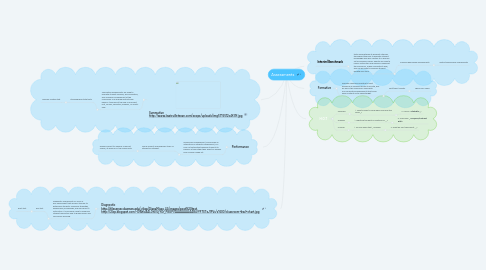Assessments
by Mariela Salinas


1. Summative http://www.lewisvilletexan.com/xoops/uploads/img5715512c4f37f.jpg
1.1. Summative assessments are used to evaluate student learning, skill acquisition, and academic achievement at the conclusion of a defined instructional period—typically at the end of a project, unit, course, semester, program, or school year.
1.1.1. Standardized State tests
1.1.1.1. Teacher created test
2. Performance
2.1. Performance assessment, also known as alternative or authentic assessment, is a form of testing that requires students to perform a task rather than select an answer from a ready-made list.
2.1.1. Group Project researching a topic of interest for student.
2.1.1.1. Design Project to address a need at school, at home or in the community.
3. Diagnostic http://fileserver.daemen.edu/~tlqp/DianaMisso_LE/images/post%20test http://2.bp.blogspot.com/-OWtla4AL0hI/UjYOr_P8GPI/AAAAAAAAAB4/YF7STxJ1FVs/s1600/classroom+kwl+chart.jpg
3.1. Diagnostic assessment is a form of pre-assessment that allows a teacher to determine students' individual strengths, weaknesses, knowledge, and skills prior to instruction. It is primarily used to diagnose student difficulties and to guide lesson and curriculum planning.
3.1.1. pre-test
3.1.1.1. post-test
4. Interim/Benchmark
4.1. tests administered at different intervals throughout the year to evaluate student knowledge and skills relative to a specific set of academic goals. Results are used to inform instruction and decision making at the classroom, school and district level, and can be used to measure student growth over time.
4.1.1. Campus Benchmark Assessments
4.1.1.1. District Benchmark Assessments
5. Formative
5.1. Planned classroom practice to elicit evidence of learning minute to minute, day by day in the classroom; along with non-summative assessments that occur while content is still being taught.
5.1.1. Exit/Admit Tickets
5.1.1.1. Think-Pair-Share
6. H.O.T
6.1. Opening
6.1.1. 1. What comes to mind when you hear the word _____?
6.1.1.1. 2. How is ___ related to ____?
6.2. Guiding
6.2.1. 1. What are the parts or features of ____?
6.2.1.1. 2. How does ____ compare/contrast with___?
6.3. Closing
6.3.1. 1. Do you agree that ___? Explain.
6.3.1.1. 2. What do you think about ____?
